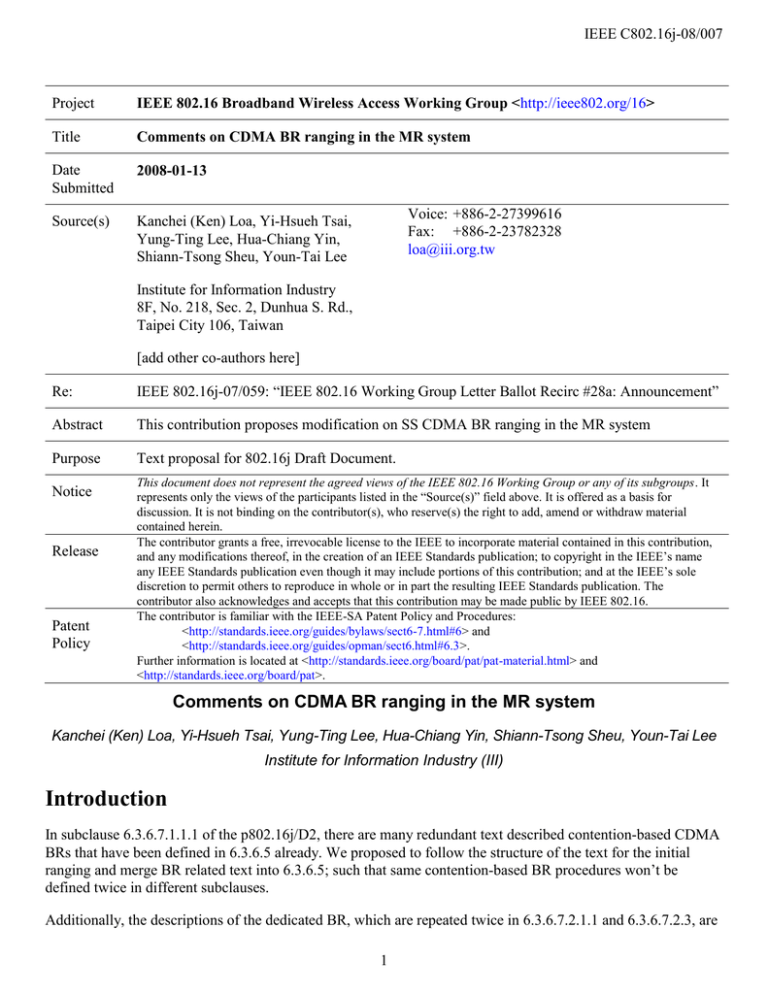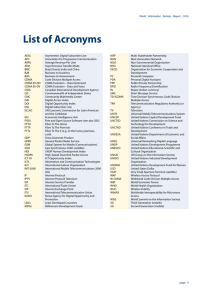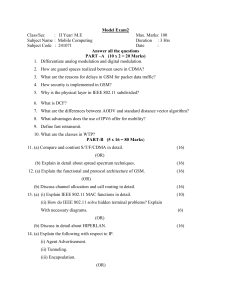IEEE C802.16j-08/007 Project Title
advertisement

IEEE C802.16j-08/007 Project IEEE 802.16 Broadband Wireless Access Working Group <http://ieee802.org/16> Title Comments on CDMA BR ranging in the MR system Date Submitted 2008-01-13 Source(s) Kanchei (Ken) Loa, Yi-Hsueh Tsai, Yung-Ting Lee, Hua-Chiang Yin, Shiann-Tsong Sheu, Youn-Tai Lee Voice: +886-2-27399616 Fax: +886-2-23782328 loa@iii.org.tw Institute for Information Industry 8F, No. 218, Sec. 2, Dunhua S. Rd., Taipei City 106, Taiwan [add other co-authors here] Re: IEEE 802.16j-07/059: “IEEE 802.16 Working Group Letter Ballot Recirc #28a: Announcement” Abstract This contribution proposes modification on SS CDMA BR ranging in the MR system Purpose Text proposal for 802.16j Draft Document. Notice Release Patent Policy This document does not represent the agreed views of the IEEE 802.16 Working Group or any of its subgroups. It represents only the views of the participants listed in the “Source(s)” field above. It is offered as a basis for discussion. It is not binding on the contributor(s), who reserve(s) the right to add, amend or withdraw material contained herein. The contributor grants a free, irrevocable license to the IEEE to incorporate material contained in this contribution, and any modifications thereof, in the creation of an IEEE Standards publication; to copyright in the IEEE’s name any IEEE Standards publication even though it may include portions of this contribution; and at the IEEE’s sole discretion to permit others to reproduce in whole or in part the resulting IEEE Standards publication. The contributor also acknowledges and accepts that this contribution may be made public by IEEE 802.16. The contributor is familiar with the IEEE-SA Patent Policy and Procedures: <http://standards.ieee.org/guides/bylaws/sect6-7.html#6> and <http://standards.ieee.org/guides/opman/sect6.html#6.3>. Further information is located at <http://standards.ieee.org/board/pat/pat-material.html> and <http://standards.ieee.org/board/pat>. Comments on CDMA BR ranging in the MR system Kanchei (Ken) Loa, Yi-Hsueh Tsai, Yung-Ting Lee, Hua-Chiang Yin, Shiann-Tsong Sheu, Youn-Tai Lee Institute for Information Industry (III) Introduction In subclause 6.3.6.7.1.1.1 of the p802.16j/D2, there are many redundant text described contention-based CDMA BRs that have been defined in 6.3.6.5 already. We proposed to follow the structure of the text for the initial ranging and merge BR related text into 6.3.6.5; such that same contention-based BR procedures won’t be defined twice in different subclauses. Additionally, the descriptions of the dedicated BR, which are repeated twice in 6.3.6.7.2.1.1 and 6.3.6.7.2.3, are 1 IEEE C802.16j-08/007 clarified. Finally, the mechanism signaling the designated transparent access RS to relay bandwidth request headers sent by the SS on the access uplink (similar mechanism has been defined in 6.3.10.3.1.1 for contention-based initial ranging) is not defined for the contention-based BR. So, we proposed a mechanism that is the same scheme used in 6.3.10.3.1.1 “MR-BS and RS behavior during contention-based initial ranging”. In order to facilitate the incorporation of this proposal into IEEE 802.16j standard, specific changes to the draft standard P802.16j/D2 are listed below. Spec changes [Insert the following subclause in P802.16REV2/D2 and modified as following indicated:] 6.3.6.5 Contention-based CDMA BRs for WirelessMAN-OFDMA The WirelessMAN-OFDMA PHY supports two mandatory contention-based BR mechanisms: the SS shall either send the BR header as specified in 6.3.6.1, or use the CDMA-based mechanism as specified in the following paragraphs of this subclause. As specified in 6.3.10.3, the OFDMA-based PHY specifies a ranging subchannel and a subset of ranging codes that shall be used for contention-based BRs. The SS/RS, upon needing to request bandwidth, shall select, with equal probability, a ranging code from the code subset allocated to BRs. This ranging code shall be modulated onto the ranging subchannel and transmitted during a Ranging Slot randomly selected from the appropriate ranging region in a single frame. Upon detection, the BS shall provide (an implementation dependent) UL allocation for the SS/RS but instead of indicating a Basic CID, the Broadcast CID shall be sent in combination with a CDMA Allocation IE, which specifies the Tx region and ranging code that were used by the SS/RS. This allows an SS/RS to determine whether it has been given an allocation by matching these parameters with the parameters it used. The SS/RS shall use the allocation to transmit a BR MPDU and/or data. The SS/RS may only omit the BR PDU when the BS indicated so in the CDMA Allocation IE (see Table 364). If the BS does not issue the UL allocation described above, or the BR MPDU does not result in a subsequent allocation of any bandwidth, the SS/RS shall assume that the ranging code transmission resulted in a collision and follow the contention resolution as specified in 6.3.8. [Modified 6.3.6.7.2.1.1 as following indicated:] 6.3.6.7.2.1.1 6.3.6.5.1 MR-BS and RS behavior during contention-based CDMA bandwidth request The MR-BS may assign unique RS CDMA ranging codes to each RS in its MR-cell in order to reduce the overhead and latency of various processes in relay networks with centralized control (see subclause 6.3.10.3.5 6.3.6.5.2). One such code may be reserved for the purpose of requesting bandwidth along the path from a specific RS to the MR-BS on which to forward a bandwidth request header; another may be reserved for the MR-Code-REP. RS CDMA ranging codes are assigned to the RS during its initial ranging process by sending an RS_CDMA_Codes TLV in the RNG-RSP. When the RS operating in centralized scheduling mode needs to request uplink bandwidth, it shall forward the appropriate RS CDMA ranging code to its superordinate station. Each intermediate RS along the path to the MR-BS shall relay this code in the uplink direction. When the MR-BS receives an RS CDMA ranging code, it shall look up which RS sent the code (there is a one-to-one mapping between RS CDMA ranging codes and RSs in the MR-cell) and create the appropriate bandwidth allocations on the relay links along the path from the RS to 2 IEEE C802.16j-08/007 the MR-BS. This requires that each RS inform the MR-BS of its processing time. [Move the paragraph in line 33 of page 83 ~ line 2 of page 84 (6.3.6.7.1.1.1) to here and modified as following indicated:] On the relay link, the contention-based CDMA bandwidth request process and its associated ranging codes are the same as those used on the access link detailed in 6.3.6.5. Alternatively, the MR-BS may assign unique RS CDMA ranging codes to each RS in its MR-cell for the purpose of requesting bandwidth from a superordinate station. RS CDMA ranging codes are assigned to the RS during its initial ranging process by sending an RS_CDMA_Codes TLV in the RNG-RSP. The ranging code shall be modulated onto the ranging subchannels and transmitted during the appropriate relay uplink allocation. Upon detection of the ranging code, the RS's superordinate station shall provide a relay uplink allocation using a CDMA_Allocation_IE specifying the transmit region and ranging code used by the RS. Once the RS determines it has been given an allocation by matching the transmit region and code it used against those specified by the CDMA_Allocation_IE, it shall use the allocation to transmit a bandwidth request header and/or data. If the superordinate station does not issue a relay uplink allocation or if the bandwidth request header does not result in a bandwidth allocation, the RS shall assume that the code is lost and retry sending the code again. The RS operating in distributed scheduling mode may reduce the latency of relaying traffic by sending a bandwidth request CDMA ranging code as soon as it receives one from a downstream station instead of waiting for the actual packets to arrive (see Figure 60b). [Figure 60b] Figure 60b—Reducing latency in relaying traffic by early transmission of BW request ranging code on the R-UL Early request bandwidth on the R-link using CDMA BR ranging code [end of the paragraph in line 33 of page 83 ~ line 27 of page 84 (6.3.6.7.1.1.1)] When a transparent RS receives a bandwidth request CDMA ranging code from a subordinate station, it shall forward an MR-Code-REP message to the MR-BS. The MR Code-REP contains the CDMA ranging code that was sent by the SS as well as its transmit region and channel adjustment information. If the transparent RS receives one or more than one bandwidth request CDMA ranging code from its subordinate SSs within one frame, it shall forward as many codes as possible (along with their transmit regions and channel adjustment information) within the MR Code-REP message based on the available uplink bandwidth. If there is not enough bandwidth for all code information, the RS shall indicate in the MR Code-REP message the number size of remaining codes to be reported. Based on this number size, the MR-BS can allocate uplink bandwidth for the remaining code information. Using the code and transmit region information the MR-BS shall generate the appropriate CDMA_Allocation_IEs that prompt the SSs to forward their bandwidth request headers on the access uplink. If management messages are relayed on the uplink, the MR-BS shall precede the CDMA_Allocation_IE with an UL_Burst_Receive_IE containing the access RS's basic CID or the multicast management CID. The MR-BS shall also create bandwidth allocations along the relay path for the purpose of forwarding these SS bandwidth request headers to the MR-BS (see Figure 60a). [Figure 60i] Figure 60i—BW request/allocation signaling in centralized scheduling mode [Move the text in line 15~25 of page 91 (6.3.6.7.2.1) to here and modified as following indicated:] 3 IEEE C802.16j-08/007 When a non-transparent RS with unique BSID operating in centralized scheduling mode receives one or more bandwidth request CDMA ranging codes in a frame from its subordinate SSs, it shall forward an MR Code-REP header using its RS basic CID to the MR-BS. The MR Code-REP header shall indicate the number of bandwidth request CDMA ranging codes the RS received. Upon receiving an MR Code-REP header from a non-transparent RS, the MR-BS shall insert CDMA Allocation IEs with certain fields zeroed out into the ULMAP that it assigns to that RS to broadcast on the access link. These CDMA_Allocation_IEs will have zeros in the fields for Frame Number Index, Ranging Code, Ranging Symbol, and Ranging Subchannel. When a nontransparent RS receives its assigned UL-MAP (see 6.3.28) from the MR-BS containing CDMA_Allocation_IEs with zeroed out fields, the RS shall fill in these fields with the appropriate ranging code and transmit region information and then broadcast this updated UL-MAP on the access link in accordance with the timing specified in Clause 6.3.30.1. [end of the text in line 15~25 of page 91 (6.3.6.7.2.1)] [Move 6.3.6.7.2.3 to 6.3.6.5 and modified as following indicated:] 6.3.6.7.2.3 6.3.6.5.2 Unique CDMA BR Ranging in relay networks with centralized bandwidth allocation In relay networks with centralized bandwidth allocation, the MR-BS shall assign unique CDMA ranging codes to each RS in its MR-cell so that it can immediately determine the purpose and the originator of the code. These codes allow the RS to quickly inform the MR-BS that it is engaged in a ranging process with one of its downstream stations and receive bandwidth from the MR-BS on which to continue or complete the process. The RS may be assigned several unique CDMA ranging codes in RNG-RSP for communicating the following requests to the MR-BS: 1) RS needs BW on its access downlink (for SS) for sending a RNG-RSP message. In this case, the RS does not send RS BR header to the MR-BS. 2) RS needs a BW allocation on the relay uplinks along the path to the MR-BS for sending a MR Code-REP message, which contain one CDMA ranging code attributes and all adjustment information. 3) RS needs BW on its relay downlink (i.e. to its subordinate RS) for sending a RNG-RSP message. In this case, the RS does not send RS BR header to the MR-BS. 4) RS needs BW allocations on the relay uplinks along the path to the MR-BS for forwarding a 6-byte header 5) RS needs BW allocations on the relay uplinks for sending HARQ error report. 6) RS to perform dedicated periodic ranging. 4




